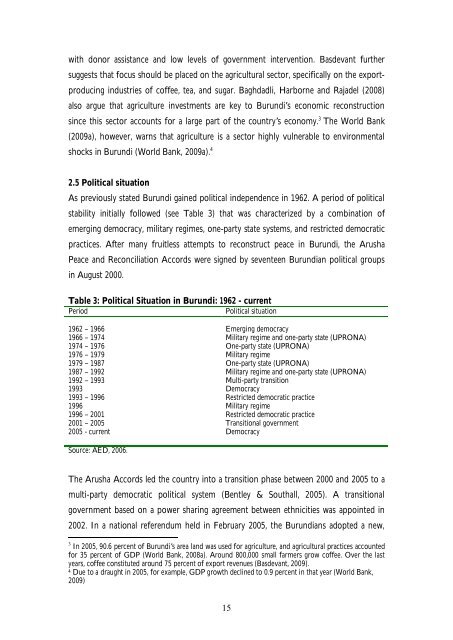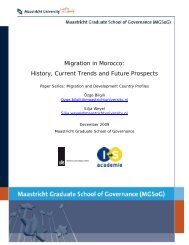Migration in Burundi: History, Current Trends and Future - MGSoG ...
Migration in Burundi: History, Current Trends and Future - MGSoG ...
Migration in Burundi: History, Current Trends and Future - MGSoG ...
You also want an ePaper? Increase the reach of your titles
YUMPU automatically turns print PDFs into web optimized ePapers that Google loves.
with donor assistance <strong>and</strong> low levels of government <strong>in</strong>tervention. Basdevant further<br />
suggests that focus should be placed on the agricultural sector, specifically on the export-<br />
produc<strong>in</strong>g <strong>in</strong>dustries of coffee, tea, <strong>and</strong> sugar. Baghdadli, Harborne <strong>and</strong> Rajadel (2008)<br />
also argue that agriculture <strong>in</strong>vestments are key to <strong>Burundi</strong>’s economic reconstruction<br />
s<strong>in</strong>ce this sector accounts for a large part of the country’s economy. 3 The World Bank<br />
(2009a), however, warns that agriculture is a sector highly vulnerable to environmental<br />
shocks <strong>in</strong> <strong>Burundi</strong> (World Bank, 2009a). 4<br />
2.5 Political situation<br />
As previously stated <strong>Burundi</strong> ga<strong>in</strong>ed political <strong>in</strong>dependence <strong>in</strong> 1962. A period of political<br />
stability <strong>in</strong>itially followed (see Table 3) that was characterized by a comb<strong>in</strong>ation of<br />
emerg<strong>in</strong>g democracy, military regimes, one-party state systems, <strong>and</strong> restricted democratic<br />
practices. After many fruitless attempts to reconstruct peace <strong>in</strong> <strong>Burundi</strong>, the Arusha<br />
Peace <strong>and</strong> Reconciliation Accords were signed by seventeen <strong>Burundi</strong>an political groups<br />
<strong>in</strong> August 2000.<br />
Table 3: Political Situation <strong>in</strong> <strong>Burundi</strong>: 1962 - current<br />
Period Political situation<br />
1962 – 1966 Emerg<strong>in</strong>g democracy<br />
1966 – 1974 Military regime <strong>and</strong> one-party state (UPRONA)<br />
1974 – 1976 One-party state (UPRONA)<br />
1976 – 1979 Military regime<br />
1979 – 1987 One-party state (UPRONA)<br />
1987 – 1992 Military regime <strong>and</strong> one-party state (UPRONA)<br />
1992 – 1993 Multi-party transition<br />
1993 Democracy<br />
1993 – 1996 Restricted democratic practice<br />
1996 Military regime<br />
1996 – 2001 Restricted democratic practice<br />
2001 – 2005 Transitional government<br />
2005 - current Democracy<br />
Source: AED, 2006.<br />
The Arusha Accords led the country <strong>in</strong>to a transition phase between 2000 <strong>and</strong> 2005 to a<br />
multi-party democratic political system (Bentley & Southall, 2005). A transitional<br />
government based on a power shar<strong>in</strong>g agreement between ethnicities was appo<strong>in</strong>ted <strong>in</strong><br />
2002. In a national referendum held <strong>in</strong> February 2005, the <strong>Burundi</strong>ans adopted a new,<br />
3 In 2005, 90.6 percent of <strong>Burundi</strong>’s area l<strong>and</strong> was used for agriculture, <strong>and</strong> agricultural practices accounted<br />
for 35 percent of GDP (World Bank, 2008a). Around 800,000 small farmers grow coffee. Over the last<br />
years, coffee constituted around 75 percent of export revenues (Basdevant, 2009).<br />
4 Due to a draught <strong>in</strong> 2005, for example, GDP growth decl<strong>in</strong>ed to 0.9 percent <strong>in</strong> that year (World Bank,<br />
2009)<br />
15



